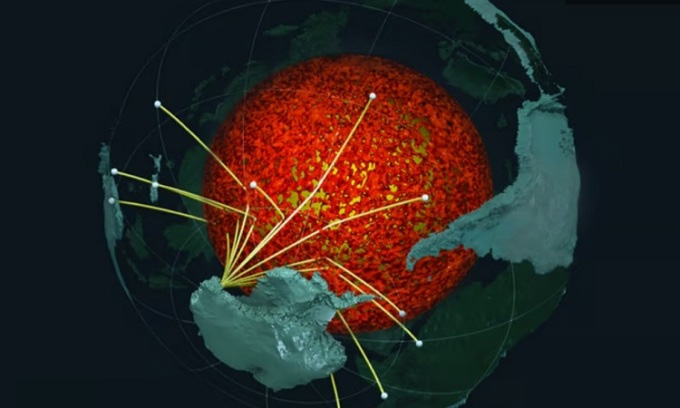Ancient ocean floor discovered surrounding Earth's core
Scientists found an ancient ocean floor deep inside the Earth with mountains five times taller than Mount Everest through seismic data .

Researchers collect seismic wave data in Antarctica. (Photo: Edward Garnero & Mingming Li).
Using seismic data collected in Antarctica over the past three years, a team of researchers has concluded that millions of years ago, the ocean floor moved toward the center of the Earth and ended up as a relatively thin layer surrounding the planet's core. The researchers say the finding could impact our understanding of how heat escapes from the core, or how ocean material can return to the surface through volcanic eruptions. They published their findings on April 5 in the journal Science Advances .
When geoscientist Samantha Hansen and colleagues from the University of Alabama (UA) set up 15 seismometers in Antarctica in 2012, they wanted to use waves from earthquakes around the planet to image mountains largely buried beneath ice. While the three-year study was successful and resulted in several papers, the data revealed unusual energy after earthquake waves crossed the core-mantle boundary (CMB) . This prompted Hansen and her colleagues to take a closer look.
The CMB lies about 2,000 miles (3,219 kilometers) below Earth's surface. There, the team found that seismic waves slowed as they hit a certain layer. Although the new layer is about 3 to 25 miles (5 to 40 kilometers) deep, it is relatively thin in terms of the planet's composition. The slowing speed at which the waves passed through earned the region the name of an extremely low velocity zone (ULVZ) .
Analyzing thousands of seismic records from Antarctica , the team's high-resolution imaging method found unusually thin regions of material in the CMB at every probe point . The thickness of the material varied from a few kilometers to tens of kilometers, suggesting they were looking at mountains at the core, some five times taller than Mount Everest, said Edward Garnero, a professor in the School of Space Science and Exploration at the University of Arizona.
The way the seismic wave slowed as it hit the ULVZ led the team to conclude it was composed of material from an ancient ocean floor that had been pushed through Earth's mantle over hundreds of millions of years. That's because such material is even denser than the liquid rock that makes up the mantle, slowing the speed of the seismic wave to the point where it shows up in the data.
Data from the study suggests that the ULVZ may encircle the entire core of the Earth. 'Seismic studies like ours provide the highest-resolution snapshot of the planet's internal structure, and we've found that this structure is much more complex than previously thought. The study provides an important link between the Earth's deep and shallow structures and planetary processes.'
- Explore the ocean
- Video: The scenery on the ocean floor if the water is dry
- Can take rare earths from the ocean
- A New Ocean Appears on Earth in an Unbelievable Place
- The 10 most shocking mysteries of the ocean floor
- The ocean floor is being torn apart off the coast of Canada
- New strange creatures are found on the deep ocean floor
- Japan discovered rare earth mines on the ocean floor
- Discovering the 720,000-year-old ice core could be a
- The surprise about the largest ocean on Earth
- Detect tremors in the deepest ocean
- 10 most shocking mysteries about the ocean floor
 'Fine laughs' - Scary and painful torture in ancient times
'Fine laughs' - Scary and painful torture in ancient times The sequence of numbers 142857 of the Egyptian pyramids is known as the strangest number in the world - Why?
The sequence of numbers 142857 of the Egyptian pyramids is known as the strangest number in the world - Why? History of the iron
History of the iron What is alum?
What is alum?